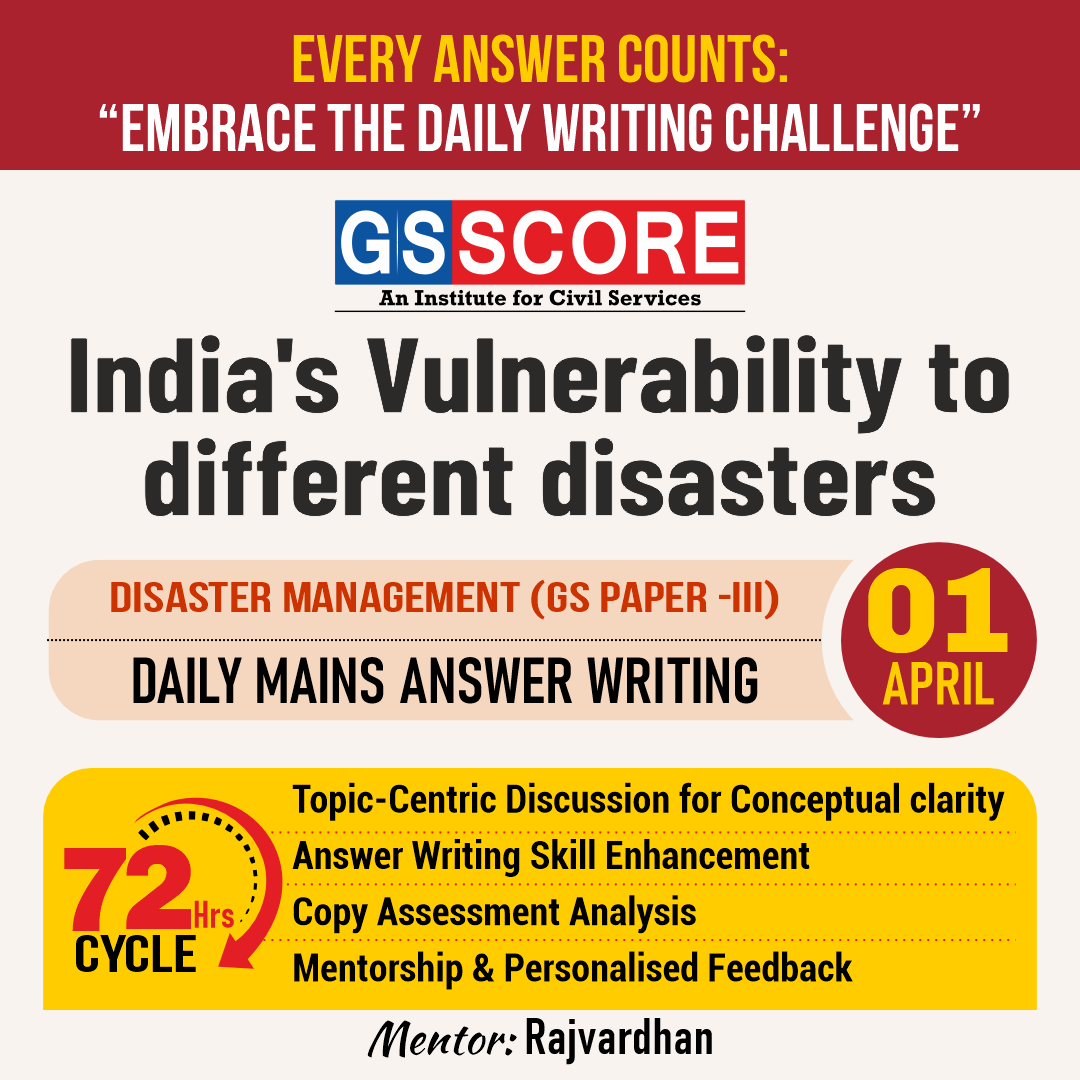


Instruction:
- There will be 2 questions carrying the First Question is-10 marks Write your answers in 150 words and the Second Question is-15 marks Write your answers in 250 words.
- Any page left blank in the answer-book must be crossed out clearly.
- Evaluated Copy will be re-uploaded on the same thread after 2 days of uploading the copy.
- Discussion of the question and one to one answer improvement session of evaluated copies will be conducted through Google Meet with concerned faculty. You will be informed via mail or SMS for the discussion.
Question #1. Discuss the causes of heat waves and India's Vulnerability to heat waves. 10 marks (150 words)
Question #2. Why forest fires are increasing in India? Suggest measures to control forest fires. 15 marks (250 words)
(Examiner will pay special attention to the candidate's grasp of his/her material, its relevance to the subject chosen, and to his/ her ability to think constructively and to present his/her ideas concisely, logically and effectively).
STEPS & INSTRUCTIONS for uploading the answers
Step 1 - The Question for the day is provided below these instructions. It will be available at 7:00 AM.
Step 2 - Uploading of Answers : Write the answer in A4 Sheet leaving proper margins for comments and feedback and upload the PDF in MY ACCOUNT section. Click on the option of SUBMIT COPY to upload the PDF.
Step 3 - Deadline for Uploading Answers: The students shall upload their answers by 7:00 PM in the evening same day. The first 50 copies will be evaluated.
Step 4 - Feedback : Mentors will give their feedback for the answers uploaded. For more personalised feedback, join our telegram channel by clicking on the link https://t.me/mains_answer_writing_cse . A one-to-one session will be conducted with the faculty after copy evaluation in 72 Hrs.
Model Answer
Question #1. Discuss the causes of heat waves and India's Vulnerability to heat waves. 10 marks (150 words)
Ans
Scorching Reality: Heat Waves and India's Vulnerability
Heat waves, periods of abnormally high temperatures, are becoming a harsh reality for India. Several factors contribute to this scorching situation:
Climate Change: The primary culprit is global warming. Rising average temperatures due to greenhouse gas emissions increase the likelihood of extreme heat events.
Urbanization: Cities trap heat due to the "urban heat island effect." Buildings and pavement absorb and retain heat, creating hotter microclimates compared to rural areas.
Deforestation: Forests cool the environment through shade and evapotranspiration. Less vegetation means less cooling, allowing temperatures to soar.
Air Pollution: Pollutants like smog act like a blanket, trapping heat near the ground. This intensifies heat waves and reduces nighttime cooling.
India's vulnerability to heat waves is particularly high due to several reasons:
Dense Population: A large population means more people are exposed to the dangers of extreme heat, especially in densely populated urban areas.
Limited Infrastructure: Many lack access to air conditioning or proper cooling facilities, making it difficult to escape the heat.
Outdoor Work: A significant portion of the workforce labors outdoors in agriculture and construction, putting them at higher risk of heat stress.
Water Scarcity: Heat waves exacerbate water scarcity, further impacting health and hygiene.
These factors combine to create a perfect storm for heat-related illnesses and fatalities. Dehydration, heat stroke, and worsening pre-existing medical conditions are just some of the dangers.
Understanding the causes and vulnerabilities is crucial for India to combat heat waves. Early warning systems, public awareness campaigns, promoting heat-resistant infrastructure, and urban planning that incorporates green spaces are all essential steps towards a cooler future.
Question #2. Why forest fires are increasing in India? Suggest measures to control forest fires. 15 marks (250 words)
Ans
Forest fires are raging more frequently in India due to a dangerous mix of human actions and environmental shifts.
Climate Change: Rising temperatures and drier conditions caused by global warming create a tinderbox environment where fires start and spread easily.
Human Activity: Up to 95% of forest fires in India are started by humans. This includes burning agricultural waste, improperly discarded cigarettes, accidental campfires, and even deliberate arson.Shifting Practices: Traditional controlled burns, used to manage undergrowth, may be becoming less frequent due to fear of fires getting out of control.
Here are some measures that could help control forest fires in India:
Public Awareness: Educating communities about responsible forest use and the dangers of uncontrolled fires is crucial.
Controlled Burns: Reintroducing controlled burns under supervision can help clear flammable undergrowth and prevent larger wildfires.
Forest Management: Regularly clearing dead leaves and debris from forests reduces potential fuel for fires.
Early Warning Systems: Investing in technology to detect and locate fires early allows for a quicker response.
Improved Infrastructure: Equipping firefighters with better training and equipment enhances their ability to combat blazes.
Law Enforcement: Stricter enforcement of laws against arson and illegal burning can serve as a deterrent.
Sustainable Practices: Promoting alternatives to agricultural burning, such as composting, can lessen fire risks.
By addressing both human behavior and environmental factors, India can work towards a future with fewer devastating forest fires.



